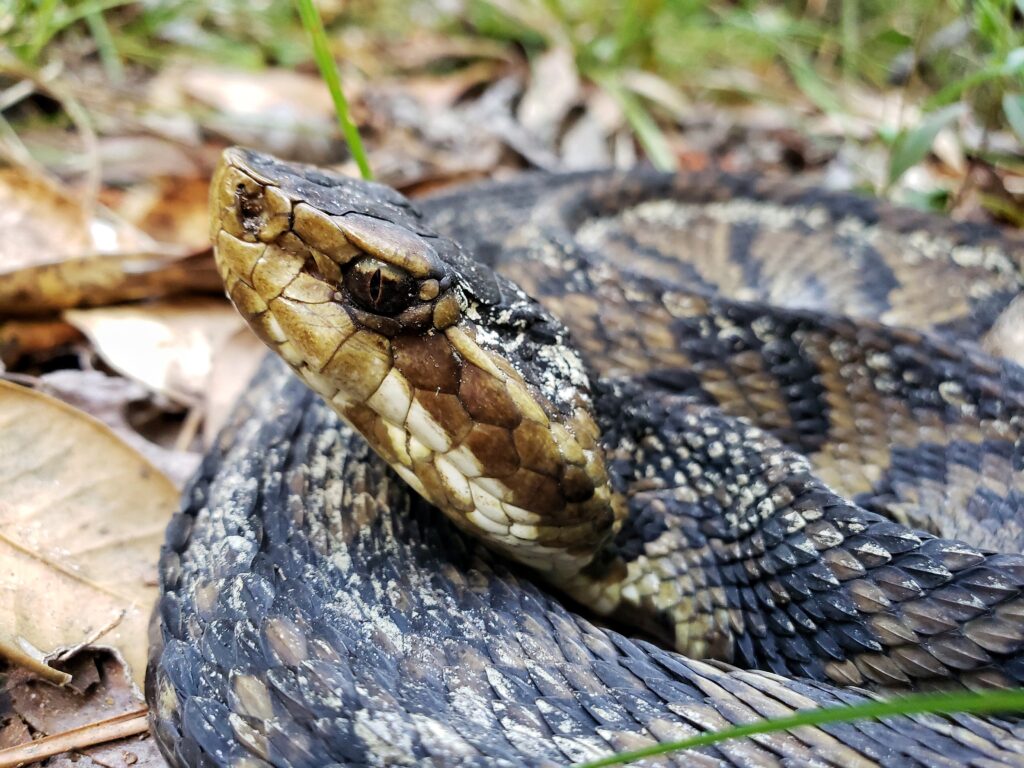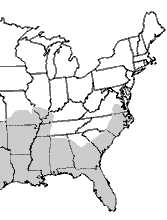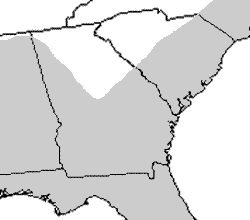Cottonmouth / Water Moccasin (Agkistrodon piscivorus) – Venomous



Photos by Amanda Hurst unless otherwise noted
| Description: Cottonmouths are venomous semi-aquatic snakes often referred to as “water moccasins.” They have large, triangular heads with a dark line through the eye, elliptical pupils, and large jowls due to the venom glands. They are large – typically 24 – 48 in (61 – 122 cm), occassionally larger, keeled-scaled, heavy-bodied snakes. Their coloration is highly variable: they can be beautifully marked with dark crossbands on a brown and yellow ground color or completely brown or black. Older adults are often dark and solid-colored whereas the juveniles are brightly patterned with a sulphur yellow tail tip that they wiggle to attract prey. The belly typically has dark and brownish-yellow blotches with the underside of the tail being black. As pit-vipers they have facial pits that sense heat and are used to detect prey and predators. Male cottonmouths are larger than females.
Range and Habitat: Cottonmouths range throughout the Southeast, north to southeastern Virginia. In our region cottonmouths are generally restricted to the Coastal Plain but are found in a few Piedmont locations west of Atlanta, Georgia. They can be found in nearly all freshwater habitats but are most common in cypress swamps, river floodplains, and heavily-vegetated wetlands. Cottonmouths will venture overland and are sometimes found far from permanent water. Cottonmouths often congregate around drying pools in wetlands to feed on trapped fish and amphibians. Habits: Cottonmouths can be found during the day or night, but forage primarily after dark during the hotter parts of the season. Throughout much of their range, they can be found year-round, even in sunny days in the winter. Cottonmouths bask on logs, rocks, or branches at the water’s edge but seldom climb high in trees (unlike many of the nonvenomous watersnakes which commonly bask on branches several feet above the water). They employ both ambush and active foraging strategies. Cottonmouths are opportunistic feeders and are known to consume a variety of aquatic and terrestrial prey, including amphibians, lizards, snakes (including smaller cottonmouths), small turtles, baby alligators, mammals, birds, and especially fish. Cottonmouths mate in the early summer at which time male-to-male combat occurs in competition for females. Females have litters of 1-20 live young every 2-3 years. The young are large (20-33 cm) and have bright yellow tail tips. The cottonmouth receives its name from the whiteness of the interior of its mouth that it exposes as a defensive display. This species is often confused with nonvenomous watersnakes, but watersnakes typically flee immediately if on land or in a tree, usually going underwater, whereas cottonmouths frequently stand their ground and gape to deter a predator. Despite their aggressive reputation, research has indicated that cottonmouths will seldom bite unless stepped on or picked up. When not alarmed, cottonmouths can be readily recognized when swimming because most of their body is above the water’s surface. Conservation Status: Cottonmouths are fairly common and are not listed at the state, federal, or heritage level. However, in many parts of their range they are killed by humans. Cottonmouths travel overland and will migrate between areas in response to drought. Therefore, they are especially vulnerable to the threats of habitat loss and fragmentation. Pertinent References: Willson, J. D., C. T. Winne, M. E. Dorcas, and J. W. Gibbons. 2006. Post-drought responses of semi-aquatic snakes inhabiting an isolated wetland: Insights on different strategies for persistence in a dynamic habitat. Wetlands 26:1071-1078. Glaudas, X., K. M. Andrews, J. D. Willson, and J. W. Gibbons. 2007. Migration patterns in a population of cottonmouths (Agkistrodon piscivorus) inhabiting an isolated wetland. Journal of Zoology 271:119-124. Glaudas, X. 2004. Do cottonmouths (Agkistrodon piscivorus) habituate to human confrontations? Southeastern Naturalist 3:129-138. Glaudas, X., and J. W. Gibbons. 2005. Do thermal cues influence the defensive strike of cottonmouths (Agkistrodon piscivorus)? Amphibia-Reptilia 26:264-267. Glaudas, X., C. T. Winne, and L. A. Fedewa. 2006. Ontogeny of anti-predator behavioral habituation in cottonmouths (Agkistrodon piscivorus). Ethology 112:608-615. Glaudas, X., and C. T. Winne. 2007. Do warning displays predict striking behavior in a viperid snake, the cottonmouth (Agkistrodon piscivorus)? Canadian Journal of Zoology 85:574-578. Scott, D. E., R. U. Fischer, J. D. Congdon, and S. A. Busa. 1995. Whole body lipid dynamics and reproduction in the eastern cottonmouth, Agkistrodon piscivorus. Herpetologica 51:472-487. Account Author: Kimberly Andrews, University of Georgia – edited by J.D. Willson |
